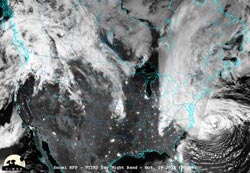NASA/NOAA's Suomi NPP captures night-time view of Sandy's landfall

As Hurricane Sandy made a historic landfall on the New Jersey coast during the night of Oct. 29, the Visible Infrared Imaging Radiometer Suite on NASA/NOAA's Suomi National Polar-orbiting Partnership satellite captured this night-time view of the storm. This image provided by University of Wisconsin-Madison is a composite of several satellite passes over North America taken 16 to18 hours before Sandy's landfall.<br><br>Credit: University of Wisconsin, CIMSS/NASA/NOAA<br>
This image provided by University of Wisconsin-Madison is a composite of several satellite passes over North America taken 16 to18 hours before Sandy's landfall.
The storm was captured by a special “day-night band,” which detects light in a range of wavelengths from green to near-infrared and uses filtering techniques to observe dim signals such as auroras, airglow, gas flares, city lights, fires and reflected moonlight. City lights in the south and mid-section of the United States are visible in the image.
William Straka, associate researcher at Cooperative Institute for Meteorological Satellite Studies, University of Wisconsin-Madison, explains that since there was a full moon there was the maximum illumination of the clouds.
“You can see that Sandy is pulling energy both from Canada as well as off in the eastern part of the Atlantic,” Straka said. “Typically forecasters use only the infrared bands at night to look at the structure of the storm. However, using images from the new day/night band sensor in addition to the thermal channels can provide a more complete and unique view of hurricanes at night.”
VIIRS is one of five instruments onboard Suomi NPP. The mission is the result of a partnership between NASA, the National Oceanic and Atmospheric Administration, and the U.S. Department of Defense.
On Monday, Oct. 29, at 8 p.m. EDT, Hurricane Sandy made landfall 5 miles (10 km) south of Atlantic City, N.J., near 39 degrees 24 minutes north latitude and 74 degrees 30 minutes west longitude. At the time of landfall, Sandy's maximum sustained winds were near 80 mph (130 kph) and it was moving to the west-northwest at 23 mph (37 kph). According to the National Hurricane Center, hurricane-force winds extended outward to 175 miles (280 km) from the center, and tropical-storm-force winds extended 485 miles (780 km). Sandy's minimum central pressure at the time of landfall was 946 millibars or 27.93 inches.
Suomi NPP was launched on Oct. 28, 2011, from Vandenberg Air Force Base, Calif. One year later, Suomi NPP has orbited Earth more than 5,000 times and begun returning images and data that provide critical weather and climate measurements of complex Earth systems.
Suomi NPP observes Earth's surface twice every 24-hour day, once in daylight and once at night. NPP flies 512 miles (824 kilometers) above the surface in a polar orbit, circling the planet about 14 times a day. NPP sends its data once an orbit to the ground station in Svalbard, Norway, and continuously to local direct broadcast users.
For storm history, images and video of Hurricane Sandy, please visit the following websites:
http://www.nnvl.noaa.gov
http://www.nasa.gov/mission_pages/hurricanes/archives/2012/h2012_Sandy.html
http://cimss.ssec.wisc.edu/goes/blog/
http://earthobservatory.nasa.gov/NaturalHazards/event.php?id=79504
Media Contact
More Information:
http://www.nasa.govAll latest news from the category: Earth Sciences
Earth Sciences (also referred to as Geosciences), which deals with basic issues surrounding our planet, plays a vital role in the area of energy and raw materials supply.
Earth Sciences comprises subjects such as geology, geography, geological informatics, paleontology, mineralogy, petrography, crystallography, geophysics, geodesy, glaciology, cartography, photogrammetry, meteorology and seismology, early-warning systems, earthquake research and polar research.
Newest articles

Silicon Carbide Innovation Alliance to drive industrial-scale semiconductor work
Known for its ability to withstand extreme environments and high voltages, silicon carbide (SiC) is a semiconducting material made up of silicon and carbon atoms arranged into crystals that is…

New SPECT/CT technique shows impressive biomarker identification
…offers increased access for prostate cancer patients. A novel SPECT/CT acquisition method can accurately detect radiopharmaceutical biodistribution in a convenient manner for prostate cancer patients, opening the door for more…

How 3D printers can give robots a soft touch
Soft skin coverings and touch sensors have emerged as a promising feature for robots that are both safer and more intuitive for human interaction, but they are expensive and difficult…




















